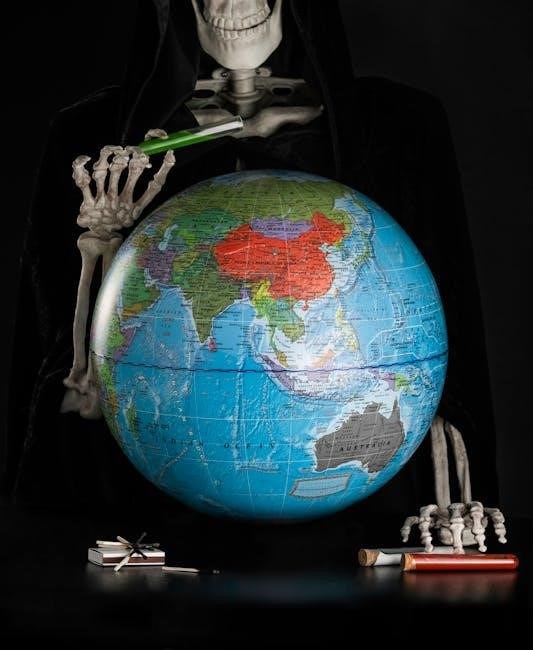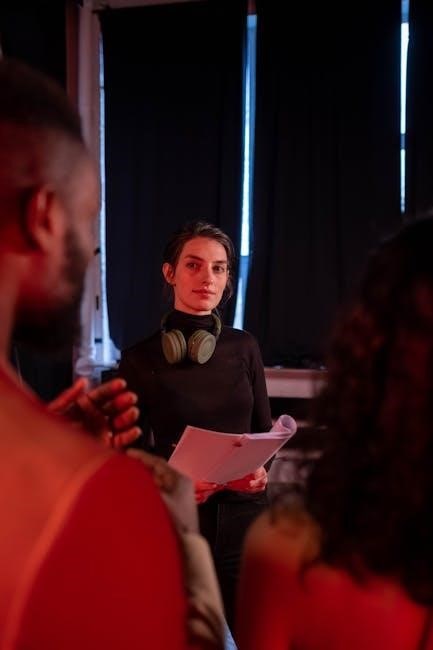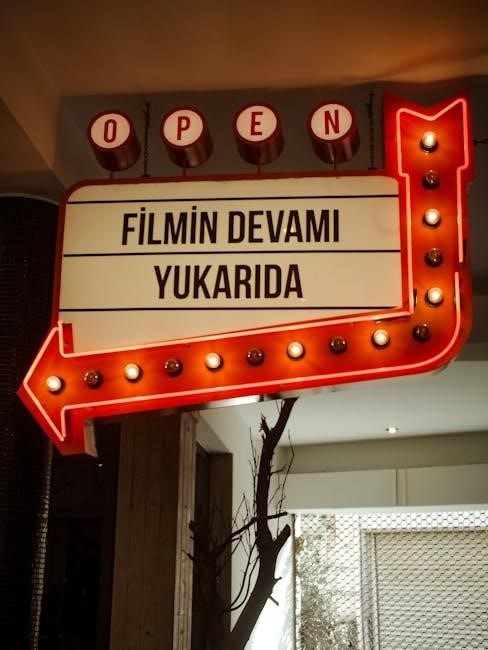Timothy Corrigan’s A Short Guide to Writing About Film offers a concise yet comprehensive approach to film analysis and criticism‚ designed for both students and enthusiasts. It bridges film theory and practical writing‚ providing clear strategies for developing critical thinking and effective communication. The guide emphasizes understanding context‚ analyzing film elements‚ and structuring essays. With practical examples and insightful discussions‚ it remains a trusted resource for exploring the art of filmmaking and writing about cinema.
Overview of the Book’s Purpose
A Short Guide to Writing About Film by Timothy Corrigan is designed to equip students and film enthusiasts with essential tools for analyzing and writing about cinema. The book serves as a bridge between film theory and practical writing‚ offering clear strategies to enhance critical thinking and communication. It emphasizes understanding film elements‚ context‚ and audience interpretation‚ while providing structured approaches to essay writing. The guide is a trusted resource for developing a deeper appreciation of filmmaking and refining the skills needed to articulate insightful film critiques.
Target Audience: Students and Film Enthusiasts

A Short Guide to Writing About Film is tailored for students and film enthusiasts seeking to enhance their analytical and writing skills. It provides practical strategies for understanding cinema‚ making it accessible to both newcomers and those with prior knowledge. The book’s clear examples and structured approach help students craft compelling essays‚ while film enthusiasts gain deeper insights into the art of storytelling. Its concise yet comprehensive nature makes it an invaluable resource for anyone passionate about exploring and interpreting films.
Key Themes and Concepts
A Short Guide to Writing About Film explores essential themes in film studies‚ including the importance of context‚ narrative structure‚ and visual style. It emphasizes understanding genre‚ the director’s role‚ and the viewer’s interpretation. The book also covers practical writing strategies‚ such as developing a thesis‚ using film examples‚ and structuring essays. Additionally‚ it delves into advanced topics like genre hybridity‚ directorial influence‚ and theoretical approaches. These concepts provide a foundation for analyzing films critically and communicating insights effectively‚ making it a comprehensive resource for film enthusiasts and scholars alike.

Understanding Film Analysis
Film analysis involves interpreting films through their cultural‚ historical‚ and social contexts‚ examining narrative structures‚ visual styles‚ and themes to uncover deeper meanings and artistic intentions.
The Importance of Context in Film Analysis
Context is essential in film analysis‚ as it shapes how films are created‚ interpreted‚ and received. Cultural‚ historical‚ and social contexts influence filmmakers’ choices and audiences’ understanding. Analyzing a film within its historical context reveals its relevance to the era’s events and societal values. Similarly‚ cultural context helps decode symbols and themes‚ while social context highlights power dynamics and representation. Without context‚ interpretations can be superficial or misleading. Corrigan emphasizes that understanding context enriches analysis‚ enabling deeper insights into a film’s purpose and significance.
Breaking Down Film Elements: Narrative‚ Genre‚ and Style
Film analysis involves examining key elements: narrative‚ genre‚ and style. Narrative refers to the storytelling structure‚ including plot‚ characters‚ and themes. Genre categorizes films into types like drama or horror‚ influencing audience expectations. Style encompasses visual and auditory techniques‚ such as cinematography‚ lighting‚ and sound‚ which create mood and tone. Understanding these elements helps critics evaluate how films communicate ideas and emotions. Corrigan emphasizes analyzing these components to uncover deeper meanings and appreciate cinematic artistry‚ enabling a more nuanced interpretation of a film’s artistic and cultural significance.
The Role of the Viewer in Interpreting Films
The viewer plays an active role in interpreting films‚ bringing personal experiences and cultural contexts to the screen. Corrigan emphasizes that meaning is not fixed but shaped by individual perspectives and critical thinking. Viewers must analyze how narrative‚ genre‚ and style interact to convey themes and emotions. Effective interpretation involves questioning assumptions and exploring multiple viewpoints‚ fostering a deeper engagement with the film. This dynamic process transforms passive watching into an enriching analytical experience‚ highlighting the collaborative nature of storytelling between filmmakers and audiences.

Writing About Film: Basic Strategies
Corrigan’s guide provides essential strategies for analyzing films‚ focusing on clear communication‚ structured critique‚ and purposeful analysis to enhance critical thinking and effective writing about cinema.
Developing a Clear Thesis Statement
A clear thesis statement is essential in film analysis‚ serving as the central argument that guides the essay. It should be specific‚ arguable‚ and relevant‚ providing a roadmap for the reader. To craft an effective thesis‚ identify key themes or elements in the film and formulate a focused argument around them. Avoid broad statements and ensure the thesis is supported by evidence from the film. For example‚ instead of stating a film is good‚ argue how it explores themes through specific techniques. The thesis should be concise‚ directing the analysis and ensuring clarity for both students and enthusiasts. Regularly review and refine it to accurately reflect the essay’s content‚ enhancing the overall impact of the analysis.
Using Specific Examples from the Film
Using specific examples from the film is crucial for a compelling analysis‚ as it grounds arguments in concrete details. Corrigan emphasizes selecting scenes that illustrate key themes or techniques‚ providing clear descriptions and analysis. When discussing a scene‚ describe its visuals‚ dialogue‚ and context‚ then explain its significance to the film’s larger themes or narrative. This approach strengthens credibility and engages readers‚ making analysis more persuasive and insightful. Always ensure examples align with the thesis‚ avoiding tangents‚ and use precise language to convey their relevance effectively.
Corrigan underscores the importance of a well-structured essay‚ beginning with a clear introduction that presents the thesis and establishes context. The body paragraphs should each focus on a key argument‚ supported by specific film examples and analysis. Use topic sentences to guide each paragraph‚ ensuring a logical flow of ideas. The conclusion should summarize the main points‚ reflect on the analysis‚ and offer final insights without introducing new ideas. This structure ensures clarity‚ coherence‚ and a persuasive presentation of your critical perspective on the film.
Exploring Film Genres
Film genres categorize movies based on themes‚ styles‚ and audience expectations‚ aiding analysis and understanding. Major genres like drama‚ comedy‚ horror‚ and action provide frameworks for storytelling and viewer engagement. Hybrid genres blend traditional categories‚ reflecting evolving cinematic trends and diverse narratives.

Defining Genre and Its Role in Film Studies
Genre categorizes films based on shared themes‚ styles‚ and audience expectations‚ serving as a framework for analysis and understanding. It influences how stories are structured and received‚ guiding filmmakers in conveying themes effectively and audiences in anticipating narratives. Genres evolve over time‚ reflecting cultural shifts and artistic innovation. While they provide creative boundaries‚ they also allow for hybridization and reinterpretation. Understanding genre is essential for critically analyzing films‚ as it reveals how cinematic traditions shape and are shaped by societal values and storytelling practices.

Major Film Genres: Drama‚ Comedy‚ Horror‚ and Action
Drama explores complex human emotions and real-life issues‚ often focusing on character development and emotional depth. Comedy emphasizes humor‚ satire‚ and lighthearted narratives‚ frequently using wit or absurdity to entertain. Horror evokes fear and tension‚ relying on suspense and supernatural or psychological elements to unsettle audiences. Action prioritizes thrilling sequences‚ physicality‚ and fast-paced plots‚ often highlighting heroism or conflict. These genres provide frameworks for storytelling‚ shaping audience expectations and offering filmmakers ways to convey themes and emotions effectively through cinematic traditions.
Hybrid Genres and Their Significance
Hybrid genres blend elements from two or more traditional genres‚ creating unique storytelling opportunities. Examples include romantic comedies‚ sci-fi horrors‚ and action dramas. These combinations allow filmmakers to explore diverse themes‚ appeal to broader audiences‚ and innovate within established genre conventions. Hybrid genres challenge rigid categorizations‚ enabling fresh perspectives and creative freedom. They reflect evolving audience tastes and cultural shifts‚ offering richer narratives by merging familiar elements with unexpected twists. This fusion not only expands storytelling possibilities but also highlights the dynamic nature of cinematic genres.
Director Studies

Director Studies explores the auteur theory‚ analyzing iconic directors’ styles and influences. It evaluates their impact on film history and industry trends through detailed case studies.

The Auteur Theory: Understanding Directorial Style
The auteur theory posits that a director’s body of work reflects a unique personal style and recurring themes. By analyzing consistent visual motifs‚ narrative patterns‚ and emotional tones across films‚ viewers can identify a director’s signature. This approach emphasizes the director as the primary author of a film‚ influencing its artistic and emotional impact. Corrigan’s guide highlights how understanding directorial style enhances film analysis‚ allowing viewers to trace thematic and stylistic evolution in a director’s career‚ such as Alfred Hitchcock’s mastery of suspense or Stanley Kubrick’s meticulous visual compositions.
Case Studies: Analyzing the Work of Iconic Directors
Case studies of iconic directors like Alfred Hitchcock‚ Stanley Kubrick‚ and Akira Kurosawa reveal their unique styles and thematic obsessions. These analyses highlight how directors imprint their films with personal visions‚ such as Hitchcock’s mastery of suspense or Kubrick’s meticulous visual compositions. By examining their careers‚ students and enthusiasts gain insights into how consistent motifs and techniques shape a director’s legacy. Such studies demonstrate how a director’s body of work reflects their artistic evolution and cultural influence‚ providing a deeper understanding of filmmaking as an art form.
Evaluating a Director’s Influence on Film History
Evaluating a director’s influence on film history involves analyzing their innovative techniques‚ thematic contributions‚ and lasting impact on cinema. Directors like Orson Welles‚ with Citizen Kane‚ revolutionized storytelling‚ while Hitchcock’s suspenseful mastery shaped genres. Kurosawa’s compositions influenced global filmmakers‚ and Nolan’s nonlinear narratives redefined modern storytelling. Their work not only reflects cultural shifts but also inspires future filmmakers‚ demonstrating how individual visions can reshape the medium. Assessing their legacy reveals how they’ve transformed both filmmaking practices and audience expectations‚ leaving an indelible mark on cinematic evolution.

Film and Society
Film serves as a mirror of cultural values and social issues‚ reflecting and shaping societal norms. It influences public opinion‚ sparks dialogue‚ and inspires change‚ bridging art and reality.
Film as a Reflection of Cultural Values
Film has long served as a mirror of cultural values‚ reflecting the beliefs‚ practices‚ and societal norms of its time. Through narratives‚ characters‚ and visual elements‚ films capture the essence of a culture‚ offering insights into its moral framework‚ traditions‚ and evolving perspectives. They often highlight social hierarchies‚ gender roles‚ and ethnic identities‚ providing a window into the collective consciousness of a society. By examining films‚ viewers can trace the transformation of cultural values over time‚ revealing how cinema both reflects and shapes societal attitudes and understanding.
The Impact of Social Issues on Film Content
Social issues profoundly influence film content‚ shaping narratives and themes that resonate with contemporary concerns. Historical events‚ political movements‚ and cultural shifts often inspire filmmakers to address topics like inequality‚ justice‚ and identity. These issues not only reflect societal challenges but also spark dialogue and awareness. By incorporating real-world problems‚ films can critique existing systems‚ challenge stereotypes‚ and inspire change. This dynamic interplay between film and society ensures that cinema remains a powerful medium for exploring and commenting on the world we live in‚ fostering empathy and understanding among audiences.
Film’s Role in Shaping Public Opinion
Film plays a significant role in shaping public opinion by presenting visual and emotional narratives that influence societal attitudes and beliefs. Movies often address controversial topics‚ sparking debates and challenging existing ideologies. By portraying real or fictional scenarios‚ films can evoke empathy‚ alter perspectives‚ and encourage critical thinking. They also serve as a platform for social commentary‚ highlighting injustices or promoting tolerance. The emotional connection audiences form with stories on screen can lead to shifts in public perception‚ making cinema a powerful tool for inspiring change and fostering cultural understanding.
Advanced Film Analysis Techniques
Advanced film analysis techniques involve methodologies like psychoanalytic‚ feminist‚ and Marxist approaches. These frameworks help analyze themes‚ characters‚ and cultural contexts‚ enhancing critical insights into classic and contemporary films.
Psychoanalytic and Feminist Approaches
Psychoanalytic approaches explore themes of identity‚ desire‚ and psychological conflict in films‚ often linking narrative elements to unconscious motivations. Feminist critiques analyze gender roles‚ representation‚ and power dynamics‚ challenging stereotypes and highlighting female agency. These methodologies encourage deeper interpretations of cinematic texts‚ revealing underlying social and psychological complexities. By applying these frameworks‚ viewers gain a richer understanding of how films reflect and shape cultural attitudes toward gender and human behavior. Corrigan’s guide emphasizes their value in advanced analysis for critical insights into film narratives and societal influences.
Marxist and Postcolonial Perspectives
Marxist film analysis examines power relations‚ class struggle‚ and economic ideologies within cinematic narratives‚ often uncovering how films reflect or challenge capitalist structures. Postcolonial perspectives focus on colonialism’s impact‚ cultural identity‚ and representation‚ emphasizing voices marginalized by colonial histories. Both approaches encourage viewers to critique societal power dynamics and cultural narratives. By applying these frameworks‚ films can be analyzed for their political and social implications‚ offering deeper insights into their historical and cultural contexts. These methodologies highlight the importance of critical theory in understanding cinema’s role in shaping societal attitudes and power relations.
Using Film Theory in Practical Analysis
Film theory provides critical frameworks for analyzing movies‚ enabling deeper understanding of their themes‚ symbols‚ and cultural contexts. By applying theories like Marxism‚ feminism‚ or psychoanalysis‚ viewers can uncover underlying meanings and power dynamics. Practical analysis involves identifying how visual and narrative elements align with theoretical concepts. This approach transforms passive viewing into an active engagement with the film’s structure and ideology. Using theory as a tool‚ analysts can interpret films as reflections of societal values‚ political ideologies‚ or psychological constructs‚ enriching both personal and academic understanding of cinema.

Writing About Film: Advanced Topics
Exploring advanced strategies for film analysis‚ this section delves into comparative studies‚ adaptation critiques‚ and engaging with critical reviews‚ offering deeper insights into cinematic interpretation and evaluation.
Comparative Analysis: Contrasting Films
Comparative analysis involves examining two or more films to highlight their differences and similarities‚ offering deeper insights into themes‚ styles‚ and cultural contexts. By contrasting narratives‚ genres‚ or directorial approaches‚ this method enhances critical understanding and reveals unique perspectives. Effective comparisons require clear criteria‚ such as thematic focus or stylistic elements‚ to frame the analysis. This approach not only sharpens analytical skills but also fosters a broader appreciation of cinematic diversity and the evolution of filmmaking techniques over time‚ enriching both academic and enthusiast discussions.
Exploring Film Adaptations and Their Sources
Film adaptations offer a unique lens to explore how stories transition from one medium to another‚ often revealing new interpretations or emphasizing different themes. Analyzing these works involves comparing the original source material‚ such as novels or plays‚ with the film version to identify changes in narrative‚ character development‚ and tone. This process examines the challenges and opportunities of adaptation‚ highlighting how filmmakers interpret and transform written content for the screen. It also explores the cultural and artistic significance of these transformations‚ providing insights into both mediums’ strengths and limitations.
Addressing Film Criticism and Reviews
Film criticism and reviews play a crucial role in shaping public opinion and understanding of cinema. Corrigan’s guide emphasizes the importance of engaging with critical perspectives while developing one’s own voice. It provides strategies for analyzing reviews‚ identifying biases‚ and evaluating the credibility of critics. The text also encourages readers to consider how cultural and personal contexts influence critical responses. By addressing film criticism‚ the guide helps students and enthusiasts refine their analytical skills and form well-supported opinions about films. This section bridges theory with practical application‚ fostering deeper engagement with cinema.
Corrigan’s guide concludes by summarizing key strategies for effective film writing‚ emphasizing critical thinking and analytical skills. It encourages readers to explore film studies further‚ fostering a deeper appreciation for cinema and its evolving narratives.
Summarizing Key Takeaways
Corrigan’s guide emphasizes the importance of context‚ critical analysis‚ and clear writing in film studies. It highlights strategies like developing a strong thesis‚ using specific examples‚ and structuring essays effectively. The book underscores the value of understanding film elements such as narrative‚ genre‚ and style‚ while encouraging viewers to engage actively with films. By fostering critical thinking and analytical skills‚ Corrigan’s approach equips readers to explore cinema thoughtfully and communicate their insights with clarity and precision. This guide remains a cornerstone for both students and film enthusiasts.
Encouraging Further Exploration of Film Studies
Corrigan’s guide motivates readers to delve deeper into film studies by highlighting its vast possibilities and interdisciplinary connections. It encourages exploring advanced theories‚ analyzing diverse genres‚ and engaging with global cinema. By providing practical strategies and inspiring critical thinking‚ the book empowers students and enthusiasts to pursue independent research and creative projects. Its emphasis on film’s cultural and social relevance underscores the importance of continuous learning and exploration‚ making it a catalyst for lifelong engagement with the art of filmmaking and its evolving narratives.
The Evolution of Film Writing and Its Future
The art of film writing has evolved significantly‚ adapting to technological advancements and shifting cultural perspectives. From traditional criticism to modern digital platforms‚ film writing now embraces diverse voices and formats. The rise of streaming and global cinema has expanded storytelling opportunities‚ fostering innovative narratives. As technology like AI and virtual production reshapes filmmaking‚ the future of film writing lies in its ability to adapt and innovate‚ ensuring that it remains a dynamic and essential part of cinematic storytelling and cultural dialogue.
